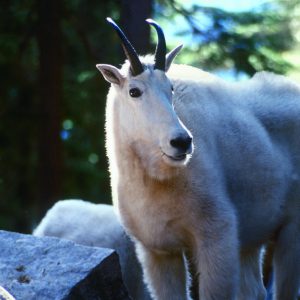From year-round endemic Cassia Crossbills to waterfowl passing through during the winter, countless bird species can be identified in and around southern Idaho’s Snake River watershed. The steep black basalt canyon walls provide shelter, the water supports plants and a nesting habitat for waterfowl, and the surrounding forests and sagebrush steppe offer sustenance for many species. Hidden amongst the reeds, willows, sagebrush sea, and thick timbered forests, you’ll find birders with binoculars glued to their eyes and spotting scopes in tow. Unlike many other recreational activities along the Snake, birdwatching requires people to slow down, be present, and pay attention to the minute details as they put the visual puzzle pieces together to positively identify the birds before them.
Birds of a feather flock together
To learn more about the Snake River’s bird population and bird advocates, we sat down with an avid Twin Falls birdwatcher Pat Weber for a bird’s-eye view of the Snake River watershed and our feathered friends that inhabit it. Our conservation with Pat, who serves as the Conservation Chair for the Prairie Falcon Audubon Society, came at the perfect time – she was planning her day to head out along the Snake to see a ruff. Not typically found in the region, the ruff was providing birders a rare experience – something that Pat always looks forward to.
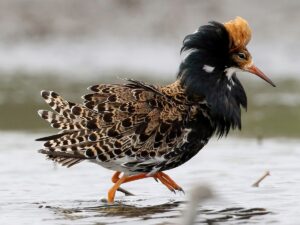
“The river isn’t just for fishing, paddleboarding, or kayaking – the birding is amazing,” said Pat. “It is a recreational activity that is a little slower paced, so everybody can do it. It is fun and brings economic value to the region – people flock from all over to see the birds here.”
Pat’s passion for birding goes back decades. A retired counselor, she moved to the Magic Valley from Challis in the early 2000s. Prior to her move south, Pat attended a Christmas Bird Count in the Pahsimeroi Valley, where she walked with bird enthusiasts identifying and counting birds – and fell in love with birding.
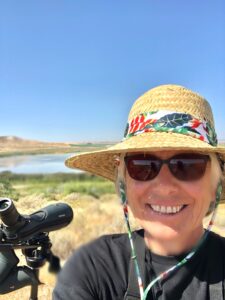
The Christmas Bird Count is the nation’s longest-running community science project – it began in 1901 under the National Audubon Society. Through the event, bird enthusiasts head to prime habitat to count as many bird species as they can, and the collected data is then used to fuel the Audubon Society’s work each year – showing how a hobby can have a real impact for our wildlife.
Ecological changes in flight
Through her birding experiences, Pat has watched ecological changes take place at a rapid rate in the Twin Falls area. Unfortunately, some of her favorite birding spots have been lost to development, climate change, pollution, and water overallocation.
“Birding is a great observational tool that lets us see what’s happening in and around the river,” said Pat. “Over time, when you’ve been birding a particular area for ten years, you start to see changes. Suddenly you lose access, the willows die, or the algae on the rocks are three inches thick. When you go somewhere enough, you start to see the changes and impact this has on wildlife.”
One of the biggest changes Pat has witnessed is the dramatic decline in waterfowl numbers each year. From her observations, the issue is multi-faceted. Part of the problem is that due to unnatural river fluctuations, waterfowl cannot nest. As the water’s edge grounds nesters, the abnormal water level fluctuates at unnatural rates, causing too high of a risk for birds to nest safely in the area. A recent report in Yosemite National Park confirms Pat’s observations, and found that irregular and unnatural river flows resulted in fewer birds breeding.
Other issues include water quality. Pat stated that at times, she sees three to four inches of sludge coating the shoreline, which makes it difficult for young avian offspring to navigate – resulting in them using excess energy to escape the confines of the sludge or slowing them down, making them more susceptible to predators.
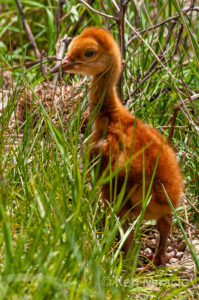
Bird populations have also been impacted by changes in agriculture practices. Historically, as natural bird habitat was lost to agricultural development, flood irrigation practices provided alternative habitats for birds. It has been argued that flood irrigation uses too much water, so many farmers have transitioned to using center pivot irrigation, which uses less water and is more affordable. When irrigation practices changed, birders and hunters alike saw decreases in southern Idaho’s pheasant and waterfowl populations.
Year after year, new reports reveal a rapid decline in bird numbers throughout the U.S. In 2021, a report found that nearly 3 billion avifauna have been lost in North America since 1970. That is an average of 58 million birds lost annually.
Many birds are indicator species, meaning they tell us what is happening in ecosystems. As we see an extreme decrease in birds in the Magic Valley, we must ask ourselves why, and work diligently to find solutions to ensure that generations will have the ecological opportunities experienced today and in the past.
“There are so many environmental concerns that birds help us understand – talk about the canary in the coal mine,” said Pat. “Current bird numbers indicate to us that things are changing rapidly. We’re seeing numbers drop drastically, less species diversity, and fewer birds are showing up. We’re noticing that just daily. For instance, hummingbirds used to arrive by the dozens in my yard, and this year, seven came. During the summer months, we used to see mallards and geese on the river by Twin Falls Park, and you rarely see them anymore.”
Weaving a nest of support for birds and water quality
There is still hope in the air for Idaho’s birds – but there’s much work to do. ICL continues to work to improve water quality and quantity throughout the Mid-Snake region, but weaving a nest of support is essential. With agriculture being the heart of southern Idaho’s economy, there must be support for farmers and dairymen to help them utilize environmentally-friendly practices, allowing them to continue feeding their families and Americans but at a lesser environmental cost.
Individual actions also help. Many individuals are working to collect data, identify issues, and create solutions for the Mid-Snake.
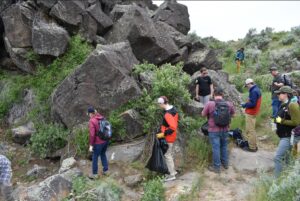
“We each have to take responsibility and look at our personal choices – from food to water to clothing,” said Pat. “Not only that, but how can we encourage manufacturers to help incentivize producers to have better practices? If I have to pay 10 cents more for my yogurt, but I know the dairy behind it was operating in a more ethical and environmentally-friendly manner, then I’m OK with that. It’s better for the environment, for the farmer, and for us.”
Another way to build support for cleaning up the Mid-Snake is connecting people to the land and water. While that may be fishing, hiking, or kayaking for some people, for Pat – it continues to be birding.
“Buhl, Twin Falls, and Hagerman are three primary regions to birdwatch in the Magic Valley,” said Pat. “Along the Snake River Canyon rim, birders can find public access dirt roads that will take you to the bottom of the canyon, where you can explore cottonwood forests home to songbirds and golden eagles. Then there is the Rim Trail and the Yingst Grade in Jerome County, which offers excellent viewing areas for birders from near and far.”
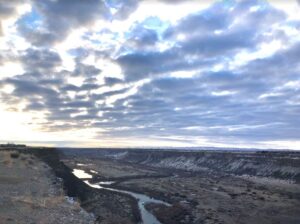
With ample birding opportunities along the southern Idaho Snake River Canyon and its watershed, birding is an excellent way to embrace the biodiverse region and learn more about the ecological changes that are taking place year after year. With winter approaching and more natural river flows, it is a great time to get out and birdwatch.
The Snake River plays an integral role in the life and livelihoods of Idahoans and contributes to the health of our families, neighbors, fish, and wildlife. Southern Idaho’s economy is tied to a healthy Snake River. Individuals from all over the world visit this region for the endless recreation opportunities provided. So many rely on the Snake River watershed’s water quality, and we must unite and work together to safeguard the river.
ICL remains committed to restoring the Snake River to a safe, swimmable, fishable condition. Making that goal a reality means we need to tackle the high levels of pollution from farms, dairies, industrial facilities, sewage treatment plants, and other sources that the Snake carries. It also means we need to support enhanced quagga mussel prevention programs following the discovery of invasive quagga mussels in the river in late 2023, and put additional funding toward the restoration of the affected section of the river. You can take action for Idaho’s Snake River below by voicing your support for these efforts, and let Idaho’s elected officials know you want to see a healthier Snake River!
If you’re interested in learning more about water quality and quantity issues in the mid-Snake region, as well as what recreation opportunities the region holds, join our Snake River email list today!

